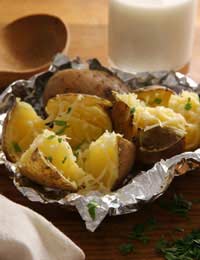Planning a Menu

Planning a menu can be harder than it sounds! You’ll want to get the right balance of meat vegetables and starchy foods; you’ll need to make sure that the starters and puds flatter the mains; lastly, and most importantly, you have to ensure that everyone has enough to eat. Cover this topic with your Children’s Cookery Group and help them find out what makes a great menu...
Foods That Go Together...
Here’s a fun activity to introduce this topic. Prepare some flavours for your group to taste. Ask them to arrange the flavours together according to how they might be served. It’s a good way to test your group’s tastebuds too: will they put coffee and chocolate together, couscous and pesto potatoes? We don’t just serve meals according to what tastes good, but also according to convention. So this exercise may even suggest a few new combinations that work beautifully. In this activity you could include:- Three pudding flavours – perhaps chocolate, rosewater and lemon.
- Three drinks – strong coffee, mint tea, and real lemonade
- Ingredients for three main dishes – couscous, pomegranate seeds, honey, soy sauce, sage stuffing, and parsley sauce.
- Three side suggestions – cold potatoes flavoured with basil pesto (or just pesto); spicy chilli greens; and celeriac puree.After your group has tasted the flavours and talked about what would go together well, discuss their final decisions. Talk to members who thought that the flavours could be combined differently. Next, discuss the factors that will influence your menu.
Balanced Flavours for your Tastebuds
Our taste buds recognise four sensations: bitter, sour, salty, and sweet. A good dish has a fine balance of all four – anything too strong will bewilder the taste buds! It’s estimated that up to 75% of ‘taste’ comes from our sense of smell – your nose tells you a lot about the food before you even open your mouth.Cultural Combinations
When it comes to planning menus, every country has its own cultural traditions. In the UK, we would probably never serve marshmallows with turkey, but Americans do just that on Thanksgiving Day. Talk to your group about their own traditions at home: what are their favourite breakfasts, lunches and dinners?Our national traditions spring from our natural produce and the harmony of the seasons. In the summer we drink punch spiked with cucumber and basil; in winter, we eat thyme-roasted potatoes and sage-stuffed chicken. In other countries, different vegetables and spices are combined according to what grows when. If you want to try something a bit different, you’re free to mix and match from different cultures – just make sure that you taste them and see if they work.


Re: Cooking and Freezing in Bulk
Many thanks for your response, that is extremely helpful even if a little complicated. I have printed this article and will pass…
Re: Cooking and Freezing in Bulk
@ Iain beg McAndrew - I think Delia refers to a 'buttery kedgeree' which isn't suitable for freezing because it is too oily. I…
Re: Cooking and Freezing in Bulk
You say that kedgeree is suitable for freezing, Delia says that it is not. As I am preparing a buffet for some 20 and wish to…
Re: Cookery Group Topics to Cover & Consider
Those are all great activities, but you can also offer to provide dishes for other groups, say for a bake…
Re: Meals for Five Pounds or Less
Cool, but, I'm looking for snacks, not meals, that you don't use an oven for (ours is broken). (but Microwaves are fine)